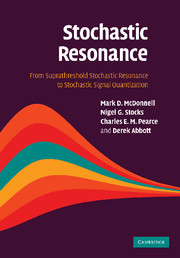Book contents
- Frontmatter
- Contents
- List of figures
- List of tables
- Preface
- Foreword
- Acknowledgments
- 1 Introduction and motivation
- 2 Stochastic resonance: its definition, history, and debates
- 3 Stochastic quantization
- 4 Suprathreshold stochastic resonance: encoding
- 5 Suprathreshold stochastic resonance: large N encoding
- 6 Suprathreshold stochastic resonance: decoding
- 7 Suprathreshold stochastic resonance: large N decoding
- 8 Optimal stochastic quantization
- 9 SSR, neural coding, and performance tradeoffs
- 10 Stochastic resonance in the auditory system
- 11 The future of stochastic resonance and suprathreshold stochastic resonance
- Appendix 1 Suprathreshold stochastic resonance
- Appendix 2 Large N suprathreshold stochastic resonance
- Appendix 3 Suprathreshold stochastic resonance decoding
- References
- List of abbreviations
- Index
- Biographies
2 - Stochastic resonance: its definition, history, and debates
Published online by Cambridge University Press: 23 October 2009
- Frontmatter
- Contents
- List of figures
- List of tables
- Preface
- Foreword
- Acknowledgments
- 1 Introduction and motivation
- 2 Stochastic resonance: its definition, history, and debates
- 3 Stochastic quantization
- 4 Suprathreshold stochastic resonance: encoding
- 5 Suprathreshold stochastic resonance: large N encoding
- 6 Suprathreshold stochastic resonance: decoding
- 7 Suprathreshold stochastic resonance: large N decoding
- 8 Optimal stochastic quantization
- 9 SSR, neural coding, and performance tradeoffs
- 10 Stochastic resonance in the auditory system
- 11 The future of stochastic resonance and suprathreshold stochastic resonance
- Appendix 1 Suprathreshold stochastic resonance
- Appendix 2 Large N suprathreshold stochastic resonance
- Appendix 3 Suprathreshold stochastic resonance decoding
- References
- List of abbreviations
- Index
- Biographies
Summary
Stochastic resonance (SR), being an interdisciplinary and evolving subject, has seen many debates. Indeed, the term SR itself has been difficult to comprehensively define to everyone's satisfaction. In this chapter we look at the problem of defining stochastic resonance, as well as exploring its history. Given that the bulk of this book is focused on suprathreshold stochastic resonance (SSR), we give particular emphasis to forms of stochastic resonance where thresholding of random signals occurs. An important example where thresholding occurs is in the generation of action potentials by spiking neurons. In addition, we outline and comment on some of the confusions and controversies surrounding stochastic resonance and what can be achieved by exploiting the effect. This chapter is intentionally qualitative. Illustrative examples of stochastic resonance in threshold systems are given, but fuller mathematical and numerical details are left for subsequent chapters.
Introducing stochastic resonance
Stochastic resonance, although a term originally used in a very specific context, is now broadly applied to describe any phenomenon where the presence of internal noise or external input noise in a nonlinear system provides a better system response to a certain input signal than in the absence of noise. The key term here is nonlinear. Stochastic resonance cannot occur in a linear system – linear in this sense means that the output of the system is a linear transformation of the input of the system. A wide variety of performance measures have been used – we shall discuss some of these later.
- Type
- Chapter
- Information
- Stochastic ResonanceFrom Suprathreshold Stochastic Resonance to Stochastic Signal Quantization, pp. 6 - 46Publisher: Cambridge University PressPrint publication year: 2008

